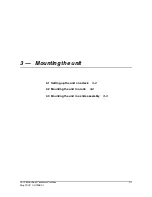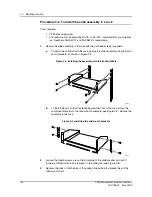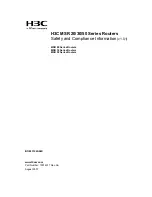
4 — Ground and power connections
2902 MainStreet Technical Practices
4-7
May 2002 90-2906-01
Table 4-1 Front panel indicators at power-up
Note
(1)
The exact behavior of the Out of Sync LEDs (after the startup sequence) depends on the node
hardware configuration and network connections.
Table 4-2 Rear panel indicators at power-up
Note
(1)
For numbers greater than 9, the first digit is shown first, followed by the second digit.
Table 4-3 describes the self-tests. In most cases, if a test fails, you should contact
your technical support representative. Exceptions are noted in the table.
If any alarms are generated as a result of the self-tests, refer to chapter 10 in
Configuration
to familiarize yourself with node management, and to chapter 25 in
Maintenance
to display the Major alarm queue.
Indicator
Description
Power LED
Turns on and stays on.
Event Status LED
System Status LED
Turn on for 1 second and then turn off. After approximately 40 seconds,
these LEDs turn on again.
Processor LED
Turns on for 1 second and then turns off. After approximately
40 seconds, the Processor LED flashes with a 50% duty cycle
(0.5 second on, 0.5 second off).
Out of Sync 1 LED
Out of Sync 2 LED
Stay off for 1 second and then turn on. After approximately 40 seconds,
these LEDs turn on again.
Indicator
Description
Power indicator
The power indicator for the Control card is the decimal point on the
seven-segment display. The decimal point is lit when the Control card
power is on.
Status LED
The Status LED turns on after the self-tests are complete (after
approximately 3 seconds). When lit, the Control card is functioning
properly.
Seven-segment display
Runs through a sequence of indications.
The display shows the letter S for approximately 1 second, indicating
the start of the self-test sequence. There are 27 self-tests. See Table
4-3 for the self-test descriptions.
Before each test, the test number is shown
. If the test fails, the
number is flashed again, followed by the letter F. The test is repeated
several times before the self-tests continue.
At the end of the self-test sequence, the letter P or F is shown,
indicating that all tests have passed or some tests have failed.
If the seven-segment display cycles its outer segments during a test,
this indicates that the current test is busy. The cycling segment affect
applies to test numbers 1 (EPROM check) and 4 (RAM).
Summary of Contents for MainStreet 2902
Page 1: ...2902 MainStreet Network Termination Unit Release 1 0 H T E C H N I C A L P R A C T I C E S ...
Page 40: ...3 Mounting the unit 3 8 2902 MainStreet Technical Practices 90 2906 01 May 2002 ...
Page 50: ...4 Ground and power connections 4 10 2902 MainStreet Technical Practices 90 2906 01 May 2002 ...
Page 68: ...6 Connecting to the network 6 4 2902 MainStreet Technical Practices 90 2906 01 May 2002 ...
Page 90: ...7 Connecting to data devices 7 22 2902 MainStreet Technical Practices 90 2906 01 May 2002 ...
Page 108: ...10 Node management 10 10 2902 MainStreet Technical Practices 90 2906 01 May 2002 ...
Page 150: ...14 CPSS 14 6 2902 MainStreet Technical Practices 90 2906 01 May 2002 ...
Page 218: ...20 Codirectional DCM 20 6 2902 MainStreet Technical Practices 90 2906 01 May 2002 ...
Page 234: ...22 HCM rate adaption 22 10 2902 MainStreet Technical Practices 90 2906 01 May 2002 ...
Page 246: ...23 Cross connecting circuits 23 12 2902 MainStreet Technical Practices 90 2906 01 May 2002 ...
Page 254: ...24 Visual indicators 24 8 2902 MainStreet Technical Practices 90 2906 01 May 2002 ...
Page 266: ...25 Alarms 25 12 2902 MainStreet Technical Practices 90 2906 01 May 2002 ...
Page 278: ...26 System diagnostics 26 12 2902 MainStreet Technical Practices 90 2906 01 May 2002 ...
Page 298: ...27 Loopbacks 27 20 2902 MainStreet Technical Practices 90 2906 01 May 2002 ...
Page 332: ...Glossary GL 8 2902 MainStreet Technical Practices 90 2906 01 May 2002 ...
Page 343: ......
Page 344: ... 2002 Alcatel All rights reserved 90 2906 01 95 1820 01 00 C ...
















































